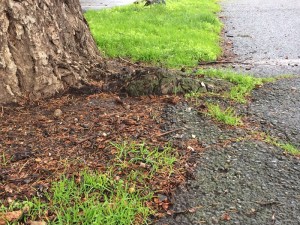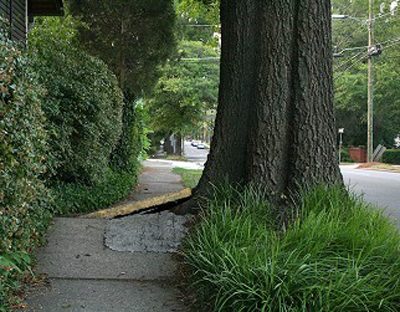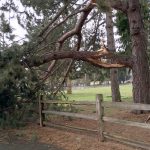What To Do When Your Tree’s Roots Are Destroying The Sidewalk
 The big, beautiful trees that line Portland’s streets help make the city what it is today. However, these tree roots often tear apart the sidewalks that lay over root systems. As tree trunks expand and roots grow stronger, the concrete sidewalk slabs can crack and lift, tripping pedestrians and making a mess of neighborhoods.
The big, beautiful trees that line Portland’s streets help make the city what it is today. However, these tree roots often tear apart the sidewalks that lay over root systems. As tree trunks expand and roots grow stronger, the concrete sidewalk slabs can crack and lift, tripping pedestrians and making a mess of neighborhoods.
If this is happening on your Portland area property, you may have already received a notice from your local government requesting that you repair the sidewalk as soon as possible. However, higher-than-expected bids from concrete contractors can sometimes be discouraging, especially when there’s a good chance you’ll just have to do this all over again in a few years.
Unless you want to keep repairing the sidewalk, you should look for a solution that gets to the root of the problem. While there is no concrete solution for this inevitable, frustrating situation, there are good and bad ways to handle the mess and control the tree’s roots.
How to Stop Tree Roots from Damaging Sidewalks
Portland is a great city to walk around. Whether it’s walking through and admiring some of Portland’s historic neighborhoods or riding your bike around one of the city’s many bridges, there is a lot to see. But with those outdoor adventures comes some precaution, including watching for raised tree roots that may have started damaging local walking areas. To keep the tree roots in your Portland area home from causing hazardous walking conditions, you’ll need to pay attention to some specific details.
 Sometimes it’s best to just remove the tree and start over. Just make sure you get permission from the city first. Cutting down the tree may not be enough to prevent root growth. You’ll also need to get rid of the stump because roots may continue to grow. Grinding is the best method of quickly getting rid of an old trunk. We grind up to 12-inches deep, getting rid of the entire stump. When you grind the stump, you can plant on the site immediately.
Sometimes it’s best to just remove the tree and start over. Just make sure you get permission from the city first. Cutting down the tree may not be enough to prevent root growth. You’ll also need to get rid of the stump because roots may continue to grow. Grinding is the best method of quickly getting rid of an old trunk. We grind up to 12-inches deep, getting rid of the entire stump. When you grind the stump, you can plant on the site immediately.
If removal isn’t an option, look for a concrete contractor. Finding the right concrete contractor will have a big impact on the outcome of repairing or replacing your sidewalk. When you shop for bids, make sure you’re contacting companies that have previously come out on the winning side of the roots versus sidewalk battle.
Your contractor should have more than a few tactics that they can use to fix the problem and prevent a recurrence. Some effective methods are:
- Putting down a layer of pea gravel under the new concrete allowing the roots to expand.
- Reinforcing the concrete with rebar so the roots have to lift several slabs at once to cause damage.
- Creating a sidewalk that bends or slopes around the tree, giving the trunk and roots room to grow.
An honest, experienced concrete contractor will explore all of these options with you.
What To Avoid When Dealing with Tree Roots
Getting rid of roots isn’t straightforward. Trees need roots to gather water and nutrients. Taking the wrong approach may be ineffective at best and harmful to your tree at worst. Here are four things to avoid:
- Don’t wait. The city will generally give you an extended period of time to address your sidewalk problem. That’s because all the arrangements, permitting, and actual work can take a while. Get started now before you’re under the gun.
- Don’t cut the roots. Only an expert should attempt to cut tree roots. Some species die after losing even a small fraction of their roots. If tree roots need to be cut, they must first be marked by the city’s arborist. Without this approval, cutting roots can easily damage or kill a tree and earn you a hefty fine. Plus, if done incorrectly trimming roots will harm your tree and make it more likely to weaken or even topple. This also applies to the ineffective method of carving an “X” on the top of a root. Excessive root pruning is often expensive and alone will not solve your problem as studies have shown that sidewalks will lift again within an average of five years.
- Don’t use growth inhibitors. When you use tree growth inhibitors, energy that normally goes to the development of the tree’s crown is redirected to the root system, which will obviously make the problem worse.
- Don’t assume the concrete has to be replaced entirely. It can be costly to replace an entire section of a sidewalk, so consider any other options your concrete contractor might have, such as patching.
Plan Ahead when Planting a Street Tree
Like with most problems, the real solution begins with prevention. The species of tree that is planted will be the biggest determinant of whether you are going to have root-and-sidewalk problems in the future. Some species are prone to invasive roots. These trees may damage sidewalks, wreak havoc on your plumbing or even invade the parts of your home.
The City of Portland and many of the surrounding cities (like Vancouver, Beaverton, Gresham, etc) can offer a handy list of tree species that are appropriate for planting between the street and the sidewalk. They should all work just as well near any sidewalk or driveway.
You’ll need a permit before you plant. The permit is free and includes an inspection. The inspector can advise you about planting locations and suitable species for your site. When you choose the right tree, you decrease the risk of problem roots in the future. Visit Portland’s website to learn about permits, tree lists and more.
Other cities around Oregon and Southwest Washington may require a permit. Check with your town’s public works department to find out what’s needed.
You can install a root barrier when trees are young to direct root growth. Barriers consist of either fabric or plastic. You’ll need to dig a trench to buy this underground fence. Bury the barrier between the tree and sidewalk, 12 to 24 inches deep with a width of at least five feet. The barrier redirects roots to grow deep under the sidewalk, eliminating the heaving caused by roots just under concrete.
Research Trees Native to Oregon
Oregon is home to a wide variety of stunning trees. Whether it’s a native coniferous species or a native broadleaf tree, there are many kinds of trees that could be a perfect addition to your front or back yard area. Before you plant your next tree, do some research on which varieties are native to Oregon and which ones may be best for your space. Some of the trees might include:
- Pacific Dogwood: Dogwood trees are known for their breathtaking white flowers. While they are often seen in the wild, they can also make great additions to any front or backyard. It prefers full sun to part shade and it can grow up to 30 feet. When the flowers are gone, orange and red berries will replace them, which provides food for the birds during the winter and autumn months.
- Bitter Cherry: This tree is oftentimes referred to as a shrub, but it develops beautiful red fruit that looks beautiful but tastes terrible. This is a deciduous tree that grows up to 50 feet tall and the flowers are highly fragrant. It’s adaptable to a wide range of temperatures and precipitation.
- Grand fir: These are one of the most traditional Christmas tree varieties out there. It is found in forests all around Oregon but it’s not uncommon to see some growing in the yards of homes around the Portland area. They prefer to be in shady, cool areas and can survive harsh winters.
Do you need a removal estimate or more advice about your trees? Contact Inexpensive Tree Care today.




